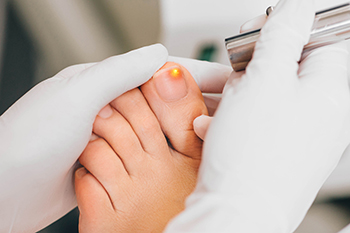Connect With Us
Blog
Items filtered by date: December 2023
Hammertoe in Children

Hammertoe, or curly toe in children is a deformity where the toe bends downward at the middle joint, resembling a hammer. It is often congenital, meaning children are born with it. Hammertoe may be flexible initially but can become fixed over time. It can occur due to an imbalance in the muscles, tendons, or ligaments that normally hold the toe straight. Wearing tight footwear and genetics can also contribute to the development of hammertoe. While it may not always cause discomfort, it can lead to issues like irritation or difficulty in fitting into shoes. If your child has hammertoe, it is suggested that you make an appointment with a podiatrist for a proper diagnosis and appropriate treatment based on its severity.
Hammertoes can be a painful condition to live with. For more information, contact Nicole C. Rodriguez, DPM of Personal Podiatry Associates. Our doctor will answer any of your foot- and ankle-related questions.
Hammertoe
Hammertoe is a foot deformity that occurs due to an imbalance in the muscles, tendons, or ligaments that normally hold the toe straight. It can be caused by the type of shoes you wear, your foot structure, trauma, and certain disease processes.
Symptoms
- Painful and/or difficult toe movement
- Swelling
- Joint stiffness
- Calluses/Corns
- Physical deformity
Risk Factors
- Age – The risk of hammertoe increases with age
- Sex – Women are more likely to have hammertoe compared to men
- Toe Length – You are more likely to develop hammertoe if your second toe is longer than your big toe
- Certain Diseases – Arthritis and diabetes may make you more likely to develop hammertoe
Treatment
If you have hammertoe, you should change into a more comfortable shoe that provides enough room for your toes. Exercises such as picking up marbles may strengthen and stretch your toe muscles. Nevertheless, it is important to seek assistance from a podiatrist in order to determine the severity of your hammertoe and see which treatment option will work best for you.
If you have any questions, please feel free to contact our offices located in Tamarac and Pembroke Pines, FL . We offer the newest diagnostic and treatment technologies for all your foot care needs.
Risk Factors for Achilles Tendon Injuries

Achilles tendon injuries can affect anyone, but certain factors increase the likelihood of tendon problems. These factors include changes in an athlete's training schedule or intensity, shifts in playing surfaces or footwear, or having tight or weak calf muscles. Additionally, excessive pronation during walking or running, and chronic ankle instability may contribute to developing an Achilles tendon injury. An individual may be at a higher risk for these injuries from leg-length discrepancies, regular high-heel use, or intense training on hills. Increasing age, the use of specific antibiotics such as fluoroquinolones, and having high-arched feet may also lead to an Achilles tendon injury. If you have one or more of these risk factors and are experiencing recurrent pain or weakness in your heel or ankle, it is suggested that you visit a podiatrist.
Achilles tendon injuries need immediate attention to avoid future complications. If you have any concerns, contact one of our podiatrists of Personal Podiatry Associates. Our doctors can provide the care you need to keep you pain-free and on your feet.
What Is the Achilles Tendon?
The Achilles tendon is a tendon that connects the lower leg muscles and calf to the heel of the foot. It is the strongest tendon in the human body and is essential for making movement possible. Because this tendon is such an integral part of the body, any injuries to it can create immense difficulties and should immediately be presented to a doctor.
What Are the Symptoms of an Achilles Tendon Injury?
There are various types of injuries that can affect the Achilles tendon. The two most common injuries are Achilles tendinitis and ruptures of the tendon.
Achilles Tendinitis Symptoms
- Inflammation
- Dull to severe pain
- Increased blood flow to the tendon
- Thickening of the tendon
Rupture Symptoms
- Extreme pain and swelling in the foot
- Total immobility
Treatment and Prevention
Achilles tendon injuries are diagnosed by a thorough physical evaluation, which can include an MRI. Treatment involves rest, physical therapy, and in some cases, surgery. However, various preventative measures can be taken to avoid these injuries, such as:
- Thorough stretching of the tendon before and after exercise
- Strengthening exercises like calf raises, squats, leg curls, leg extensions, leg raises, lunges, and leg presses
If you have any questions please feel free to contact our offices located in Tamarac and Pembroke Pines, FL . We offer the newest diagnostic tools and technology to treat your foot and ankle needs.
Risk Factors for Peripheral Artery Disease

Peripheral arterial disease, or PAD, is a vascular condition characterized by narrowed arteries in the legs, limiting blood flow to the feet. Several risk factors contribute to the development and progression of PAD. Smoking is a primary risk factor, as it damages blood vessels and promotes plaque buildup. Diabetes is another significant factor, as high blood sugar levels can damage arteries. Hypertension, or high blood pressure, places constant stress on arteries and can lead to their narrowing over time. Age is also a non-modifiable risk factor, as PAD becomes more common with advancing age. Genetics can play a role, with a family history of vascular diseases increasing one's susceptibility. Obesity and a sedentary lifestyle contribute by promoting the accumulation of fatty deposits in arteries. Additionally, high cholesterol levels can lead to plaque formation in blood vessels. Lastly, individuals with a history of heart disease are at higher risk for PAD. If you have risk factors for PAD or suffer from its effects on your feet, it is suggested that you schedule an appointment with a podiatrist for an examination and necessary treatment.
Peripheral artery disease can pose a serious risk to your health. It can increase the risk of stroke and heart attack. If you have symptoms of peripheral artery disease, consult with one of our podiatrists from Personal Podiatry Associates. Our doctors will assess your condition and provide you with quality foot and ankle treatment.
Peripheral artery disease (PAD) is when arteries are constricted due to plaque (fatty deposits) build-up. This results in less blood flow to the legs and other extremities. The main cause of PAD is atherosclerosis, in which plaque builds up in the arteries.
Symptoms
Symptoms of PAD include:
- Claudication (leg pain from walking)
- Numbness in legs
- Decrease in growth of leg hair and toenails
- Paleness of the skin
- Erectile dysfunction
- Sores and wounds on legs and feet that won’t heal
- Coldness in one leg
It is important to note that a majority of individuals never show any symptoms of PAD.
Diagnosis
While PAD occurs in the legs and arteries, Podiatrists can diagnose PAD. Podiatrists utilize a test called an ankle-brachial index (ABI). An ABI test compares blood pressure in your arm to you ankle to see if any abnormality occurs. Ultrasound and imaging devices may also be used.
Treatment
Fortunately, lifestyle changes such as maintaining a healthy diet, exercising, managing cholesterol and blood sugar levels, and quitting smoking, can all treat PAD. Medications that prevent clots from occurring can be prescribed. Finally, in some cases, surgery may be recommended.
If you have any questions, please feel free to contact our offices located in Tamarac and Pembroke Pines, FL . We offer the newest diagnostic and treatment technologies for all your foot care needs.
Laser Treatment for Toenail Fungus

Laser treatment for toenail fungus has emerged as an innovative approach to tackling this persistent and often stubborn condition. This non-invasive procedure involves using focused laser beams to target and eradicate the fungal infections that reside beneath the toenail. The laser energy penetrates the nail plate, reaching the affected area without causing harm to the surrounding healthy tissue. The heat generated by the laser effectively kills the fungus, offering a promising alternative to traditional treatments such as oral medications or topical solutions. Multiple sessions may be required for optimal results. However many individuals find laser treatment appealing due to its minimal side effects and the absence of the potential liver complications associated with oral medications. Understanding this procedure provides individuals with valuable insights into a contemporary and effective solution for addressing toenail fungus and restoring clear, healthy nails. If you have developed toenail fungus and would like detailed information about this type of treatment, it is suggested that you schedule an appointment with a podiatrist.
Laser treatment can be an effective way to get rid of toenail fungus. If you have any questions about laser treatment, consult with one of our podiatrists from Personal Podiatry Associates. Our doctors will assess your condition and provide you with quality treatment for fungal nails.
What Are Toenail Fungal Infections?
Onychomycosis, or fungal infection of the nail, is a relatively common and non-serious condition. Around 10 percent of U.S. citizens are afflicted with fungal nails. Common forms of fungus that infect the nail include dermatophytes, yeasts, and molds.
Symptoms of Toenail Fungal Infections Include:
- Nail thickening
- Brittleness of the nail
- Discoloration of the nail
Diagnosis for Fungal Nails
Fungal infections are diagnosed by fungal culture and microscopy. This will rule out any other conditions such as nail trauma, psoriasis, lichen planus, and onychogryphosis.
What Is Laser Treatment?
Laser treatment is a non-invasive, safe, quick, and painless procedure that uses the heat from a laser to kill fungus in the nail. Each infected nail is targeted with a laser for several minutes. The treatment is usually utilized several different times over a select period. During this time, a podiatrist will keep an eye on the infection.
If you have any questions, please feel free to contact our offices located in Tamarac and Pembroke Pines, FL . We offer the newest diagnostic and treatment technologies for all your foot care needs.

